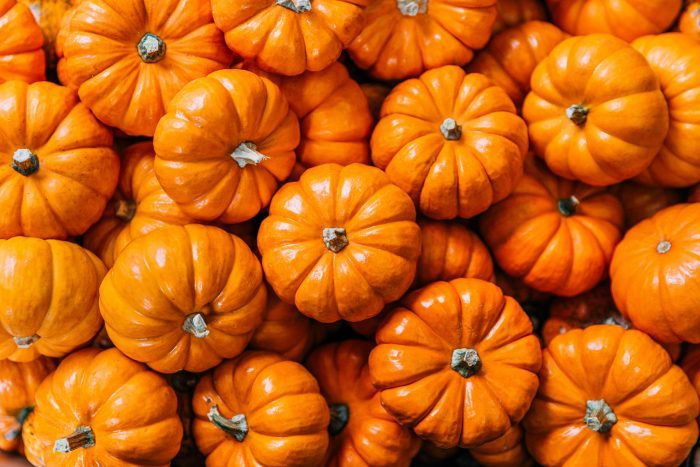The fall season shows up in many ways — pumpkin spice lattes, autumnal takes on comfort food like pumpkin ravioli, breaking out pumpkin-scented candles. No one has forgotten about apple cider doughnuts, but the everything-pumpkin craze is a sure sign that fall has officially arrived.
With pumpkin purchases skyrocketing, it’s good to know the shelf life of the seasonal fruit — yes, technically to botanists, pumpkins are fruits. So how long do pumpkins last?
Pumpkin variety and intended use make a difference, but we’ve gathered the info you need to know before you head out to buy pumpkins this fall.
How Long Do Carved Pumpkins Last?
Carving pumpkins is a full-fledged family event in our home. There’s a long tradition behind jack o’ lanterns! And there’s definitely something eerie yet whimsical about the glow of candlelit jack-o’-lanterns lining front porches, until they start to look a little off.
Don’t be surprised when your jack-o’-lanterns break down faster than their intact counterparts. Realistically, you’ll only get a few days out of your carved pumpkin before it begins to rot.
Plant Care Today says that carved pumpkins generally last between three and five days, though some can stretch it to two weeks. Keep in mind factors like weather and sunlight also affect the speed of decomposition
Pumpkins have thick, tough skin, the kind that protects a delicate inside. Once you break that protective barrier, it’s an open invite for bacteria and fungi to start breaking down the contents. Luckily, there are ways to preserve a pumpkin and get a few more weeks out of it.
How Long Do Whole Pumpkins Last?
Once harvested off the vine in September and October, healthy pumpkins will last from three months to a whole year if they’re stored properly. When choosing a pumpkin, gardener Mary Jane Duford, who writes the blog Home for the Harvest, suggests considering these factors:
- Opt for the healthiest-looking pumpkins: You might think bigger is better, but that’s not always the case. Look closely for soft spots, bruising and rot. Pumpkins can often b damaged during harvest and transportation.
- Consider cured pumpkins: Some farmers move their pumpkins from vine to a storage space kept at room temperature, which allows it to cure. Higher temps encourage the pumpkin’s outer skin, or rind, to harden, allowing it to last longer than its uncured counterparts. It’s worth asking your local farmer about their harvesting process!
- Don’t carry by the stem: If you’re about to pluck your own pumpkin from the vine, be conscious not to carry it around by the stem once. Broken, damaged stems result in shorter shelf life. Bring a pair of gloves.
How Long Do Mini Pumpkins Last?

Miniature pumpkins are perfect for fall decoration without the hassle of hauling full-sized gourds home. While there are many different colors and hybrid varieties, mini pumpkins will generally last longer than normal-sized ones.
On average, Specialty Produce says petite white pumpkins like White Gooligans and Casperitas will last between six and 12 months in the right storage conditions. More common orange varieties have a similar shelf life, unless you decide to cook them. They go great with other roasted seasonal vegetables!
How Long Do Pie Pumpkins Last?
The type used for fresh pumpkin pie is often not the same variety carved into jack-o’-lanterns. While you can still eat the latter, it probably won’t be very sweet.
Pie pumpkins, also referred to as sugar pumpkins, are smaller, denser and darker than the carving types. The pulp inside is thicker, with a rich orange color. It will have a discernibly sweeter taste than larger, more common varieties. Generally, these pumpkins come into season toward the beginning of fall and last for about three months after harvest.
How Can You Tell When a Pumpkin Has Gone Bad?
The most obvious signs are softening skin and visible decay. If a whole uncarved pumpkin begins to rot, Eat by Date says it will first soften on the bottom where it comes into contact with a surface, then begin to leak fluid.
For carved pumpkins, signs of rot — drying, browning pulp and collapse — are easier to see and will progress quickly. Either way, it’s best to get rid of these pumpkins as soon as you can. They’ll stain surfaces and attract bugs.
How Should You Store Pumpkins?
If you get your pumpkins early, a few weeks before you plan to carve them, storing them the right way will make sure they stay in shape until Halloween.
- Give them a rinse: Clean pumpkins are happy pumpkins. Soak them in a tub of water and spray them with diluted bleach or vinegar to help prevent rot. Gently pat dry with a cloth towel.
- Stay away from sunlight: The darker and drier the storage space is, the better. Direct sunlight and heat will speed up rotting, and cold temperatures can damage them. Somewhere between 50 and 60 degrees is the sweet spot, according to Gardening Know How.
- Avoid concrete: If you can, store your uncarved pumpkins on a layer of cardboard, hay or wood. Pumpkins will rot faster on concrete. You can even store them in hanging baskets!
Did you miss our previous article...
https://rsssuperfeeds.com/life-hacks/how-to-make-a-polar-bear-corner-bookmark






